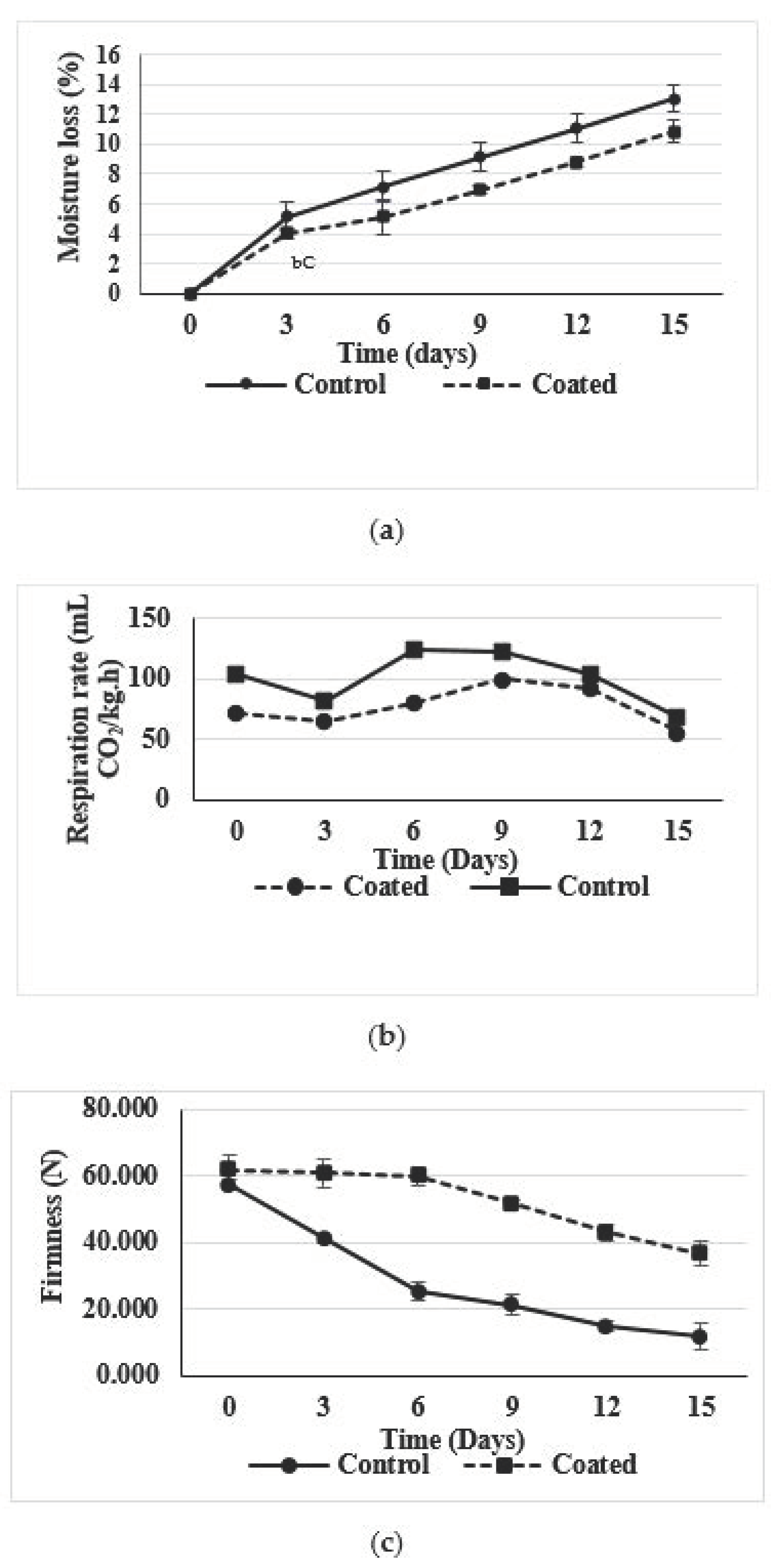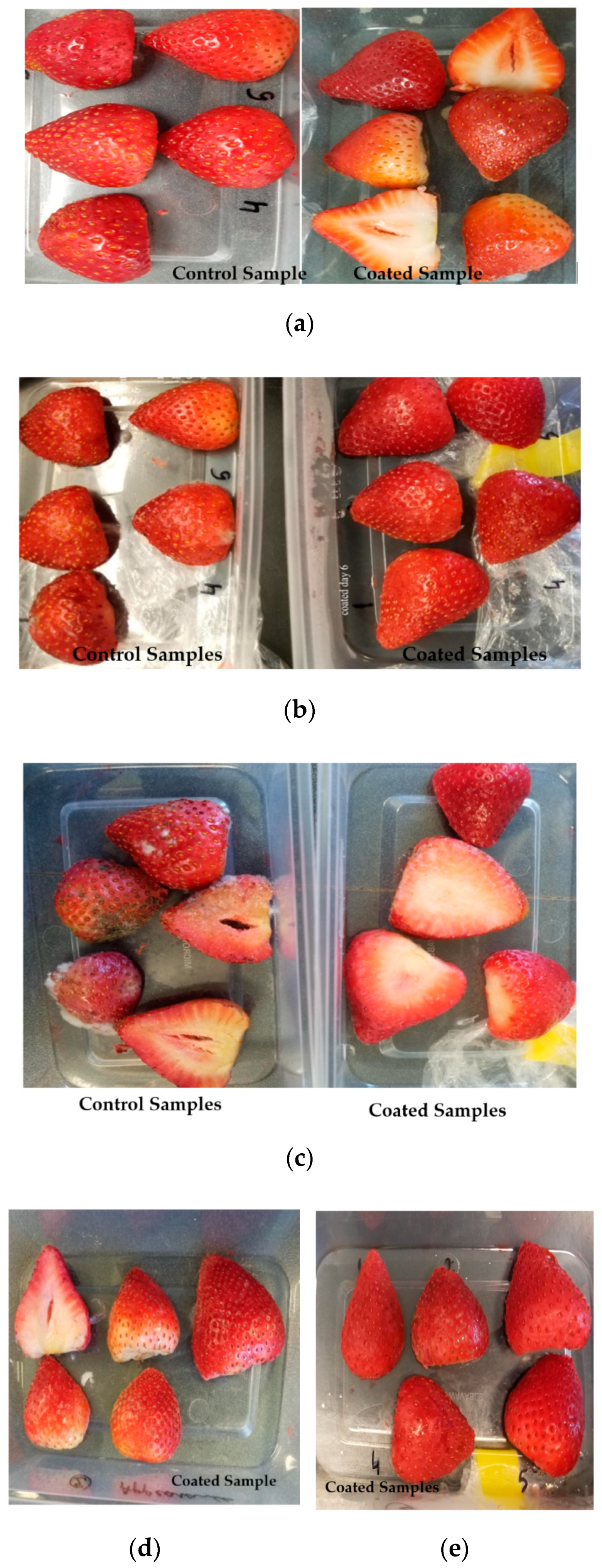The Effect of Sodium Alginate-Calcium Chloride Coating on the Quality Parameters and Shelf Life of Strawberry Cut Fruits
Abstract
:1. Introduction
2. Materials and Methods
2.1. Sample Preparation
2.2. Coating Solution Preparation
2.3. Control Sample Preparation
2.4. Sample Coating
2.5. Sample Storage
2.6. Respiration Rate
2.7. Transpiration/Weight Loss
2.8. Color
2.9. Texture
2.10. pH
2.11. Titratable Acidity
2.12. Total Soluble Solids (TSS)
2.13. Total Aerobic Count of Microorganisms
2.14. Appearance
2.15. Statistical Analysis
3. Results and Discussion
3.1. Transpiration/Weight Loss
3.2. Respiration Rate
3.3. Texture
3.4. Total Soluble Solids
3.5. pH
3.6. Titratable Acidity
3.7. Color
3.8. L Value
3.9. a * Value
3.10. C Value
3.11. Total Aerobic Count of Microorganisms
3.12. Appearance
4. Conclusions
Author Contributions
Funding
Acknowledgments
Conflicts of Interest
References
- Ramaswamy, H.S. Post-Harvest Technologies of Fruits & Vegetables; DEStech Publications Inc.: Lancaster, PA, USA, 2015. [Google Scholar]
- Siddiqui, M.W.; Rahman, S.; Wani, A.A. Innovative Packaging of Fruits and Vegetables: Strategies for Safety and Quality Maintenance. Available online: http://public.ebookcentral.proquest.com/choice/publicfullrecord.aspx?p=5400699 (accessed on 19 August 2020).
- Sabina, G.; Emine Aytunga Arik, K.; Małgorzata, G.; Karolina, K.N. Novel materials in the preparation of edible films and coatings—A review. Coatings 2020, 10, 674. [Google Scholar] [CrossRef]
- Mahfoudhi, N.; Hamdi, S. Use of almond gum and gum arabic as novel edible coating to delay postharvest ripening and to maintain sweet cherry (Prunus avium) quality during storage. J. Food Process. Preserv. 2015, 39, 1499–1508. [Google Scholar] [CrossRef]
- Singh, B.; Singh, S. Advances in Post-Harvest Technologies of Vegetable Crops. Available online: https://www.taylorfrancis.com/books/e/9781315161020 (accessed on 19 August 2020).
- Karolina, K.; Katarzyna, P.; Małgorzata, G. Pullulan—Biopolymer with potential for use as food packaging. Int. J. Food Eng. 2019, 15, 20190030. [Google Scholar] [CrossRef]
- Maftoonazad, N.; Ramaswamy, H.S. Postharvest shelf-life extension of avocados using methyl cellulose-based coating. LWT-Food Sci. Technol. 2005, 38, 617–624. [Google Scholar] [CrossRef]
- Maftoonazad, N.; Ramaswamy, H.S.; Marcotte, M. Shelf-Life extension of peaches through sodium alginate and methyl cellulose edible coatings. Int. J. Food Sci. Technol. 2008, 43, 951–957. [Google Scholar] [CrossRef]
- Vargas, M.; Pastor, C.; Chiralt, A.; McClements, D.J.; González-Martínez, C. Recent advances in edible coatings for fresh and minimally processed fruits. Crit. Rev. Food Sci. Nutr. 2008, 48, 496–511. [Google Scholar] [CrossRef] [PubMed]
- Senturk Parreidt, T.; Muller, K.; Schmid, M. Alginate-Based edible films and coatings for food packaging applications. Foods 2018, 7, 170. [Google Scholar] [CrossRef] [Green Version]
- Food and Agriculture Organization. FAOSTAT Strawberries Crops (Production). Available online: http://www.fao.org/faostat/en/#home (accessed on 19 August 2020).
- Campaniello, D.; Bevilacqua, A.; Sinigaglia, M.; Corbo, M.R. Chitosan: Antimicrobial activity and potential applications for preserving minimally processed strawberries. Food Microbiol. 2008, 25, 992–1000. [Google Scholar] [CrossRef]
- Tomadoni, B.; Moreira, M.R.; Pereda, M.; Ponce, A.G. Gellan-based coatings incorporated with natural antimicrobials in fresh-cut strawberries: Microbiological and sensory evaluation through refrigerated storage. LWT-Food Sci. Technol. 2018, 97, 384–389. [Google Scholar] [CrossRef]
- Yousuf, B.; Qadri, O.S.; Srivastava, A.K. Recent developments in shelf-life extension of fresh-cut fruits and vegetables by application of different edible coatings: A review. LWT 2018, 89, 198–209. [Google Scholar] [CrossRef]
- González-Aguilar, G.A.; Valenzuela-Soto, E.; Lizardi-Mendoza, J.; Goycoolea, F.; Martínez-Téllez, M.A.; Villegas-Ochoa, M.A.; Ayala-Zavala, J.F. Effect of chitosan coating in preventing deterioration and preserving the quality of fresh-cut papaya ‘Maradol’. J. Sci. Food Agric. 2009, 89, 15–23. [Google Scholar] [CrossRef]
- Han, C.; Zhao, Y.; Leonard, S.W.; Traber, M.G. Edible coatings to improve storability and enhance nutritional value of fresh and frozen strawberries (Fragaria ananassa) and raspberries (Rubus ideaus). Postharvest Biol. Technol. 2004, 33, 67–78. [Google Scholar] [CrossRef]
- Marcotte, M.; Taherian, A.R.; Ramaswamy, H.S. Physical properties of reconstituted carrot/alginate particles suitable for aseptic processing. J. Food Process Eng. 2000, 23, 463–480. [Google Scholar] [CrossRef]
- Izumi, H.; Watada, A.E. Calcium treatments affect storage quality of shredded carrots. J. Food Sci. 1994, 59, 106–109. [Google Scholar] [CrossRef]
- Alonso, J.; Canet, W.; Rodriguez, T. Thermal and calcium pretreatment affects texture, pectinesterase and pectic substances of frozen sweet cherries. J. Food Sci. 1997, 62, 511–515. [Google Scholar] [CrossRef]
- Garcia, L.C.; Pereira, L.M.; de Luca Sarantópoulos, C.I.G.; Hubinger, M.D. Effect of antimicrobial starch edible coating on shelf-life of fresh strawberries. Packag. Technol. Sci. 2012, 25, 413–425. [Google Scholar] [CrossRef]
- Gamboa-Santos, J.; Campañone, L.A. Application of osmotic dehydration and microwave drying to strawberries coated with edible films. Dry. Technol. 2018, 1–11. [Google Scholar] [CrossRef]
- Gol, N.B.; Patel, P.R.; Rao, T.V.R. Improvement of quality and shelf-life of strawberries with edible coatings enriched with chitosan. Postharvest Biol. Technol. 2013, 85, 185–195. [Google Scholar] [CrossRef]
- AOAC-Association of Offical Analytical Chemists. Official Method of Analysis, Titrimetric Method for Fruits; AOAC: Rockville, MD, USA, 1990. [Google Scholar]
- Velickova, E.; Winkelhausen, E.; Kuzmanova, S.; Alves, V.D.; Moldão-Martins, M. Impact of chitosan-beeswax edible coatings on the quality of fresh strawberries (Fragaria ananassa cv Camarosa) under commercial storage conditions. LWT Food Sci. Technol. 2013, 52, 80–92. [Google Scholar] [CrossRef]
- Moreira, M.R.; Cassani, L.; Martín-Belloso, O.; Soliva-Fortuny, R. Effects of polysaccharide-based edible coatings enriched with dietary fiber on quality attributes of fresh-cut apples. J. Food Sci. Technol. 2015, 52, 7795–7805. [Google Scholar] [CrossRef] [Green Version]
- Lamikanra, O.; Watson, M.A. Effect of Calcium Treatment Temperature on Fresh-cut Cantaloupe Melon during Storage. J. Food Sci. 2004, 69, C468–C472. [Google Scholar] [CrossRef]
- Narayanapurapu, P. Effect of Composite Edible Coatings and Abiotic Stress on Post Harvest Quality of Fruits; McGill University Libraries: Montreal, QC, Canada, 2012. [Google Scholar]
- Yan, J.; Luo, Z.; Ban, Z.; Lu, H.; Li, D.; Yang, D.; Li, L. The effect of the layer-by-layer (LBL) edible coating on strawberry quality and metabolites during storage. Postharvest Biol. Technol. 2019, 147, 29–38. [Google Scholar] [CrossRef]
- Collins, J.K.; Perkins, V.P. Postharvest Changes in Strawberry Fruit Stored Under Simulated Retail Display Conditions. J. Food Qual. 1993, 16, 133–143. [Google Scholar] [CrossRef]
- Soazo, M.; Pérez, L.M.; Rubiolo, A.C.; Verdini, R.A. Prefreezing application of whey protein-based edible coating to maintain quality attributes of strawberries. Int. J. Food Sci. Technol. 2015, 50, 605–611. [Google Scholar] [CrossRef]
- Khodaei, D.; Hamidi-Esfahani, Z. Influence of bioactive edible coatings loaded with Lactobacillus plantarum on physicochemical properties of fresh strawberries. Postharvest Biol. Technol. 2019, 156, 110944. [Google Scholar] [CrossRef]






| Samples | Day 0 | Day 3 | Day 6 | Day 9 | Day 12 | Day 15 | |
|---|---|---|---|---|---|---|---|
| L values | Control | 31.6 ± 1.1 a,A | 26.9 ± 0.8 b,B | 25.6 ± 1.6 b,C | 24.0 ± 1.5 c,C | 22.5 ± 1.5 c,D | 20.8 ± 2.8 d,E |
| Coated | 31.3 ± 1.0 a,A | 30.8 ± 0.8 a,C | 30.6 ± 0.2 a,D | 29.9 ± 1.4 b,D | 27.1 ± 0.3 b,E | 26.7 ± 0.5 b,F | |
| a * values | Control | 32.4 ± 0.2 a,A | 31.2 ± 0.9 a,A | 30.3 ± 2.6 b,A | 29.3 ± 0.8 c,A | 27.4 ± 1.9 d,B | 26.4 ± 2.6 e,C |
| Coated | 32.6 ± 1.3 a,A | 31.3 ± 0.7 b,A | 29.3 ± 2.0 c,A | 29.0 ± 2.0 c,A | 30.0 ± 2.1 b,B | 32.0 ± 0.6 a,D | |
| C values | Control | 37.8 ± 0.4 a,A | 35.7 ± 1.0 b,A | 34.8 ± 3.8 b,A | 33.7 ± 1.0 b,A | 31.9 ± 3.4 c,A | 29.9 ± 3.7 c,B |
| Coated | 38.3 ± 1.1 a,A | 34.0 ± 1.1 b,A | 35.1 ± 3.9 b,A | 33.9 ± 2.1 b,A | 34.6 ± 2.6 b,A | 36.2 ± 1.3 b,C |
© 2020 by the authors. Licensee MDPI, Basel, Switzerland. This article is an open access article distributed under the terms and conditions of the Creative Commons Attribution (CC BY) license (http://creativecommons.org/licenses/by/4.0/).
Share and Cite
Alharaty, G.; Ramaswamy, H.S. The Effect of Sodium Alginate-Calcium Chloride Coating on the Quality Parameters and Shelf Life of Strawberry Cut Fruits. J. Compos. Sci. 2020, 4, 123. https://doi.org/10.3390/jcs4030123
Alharaty G, Ramaswamy HS. The Effect of Sodium Alginate-Calcium Chloride Coating on the Quality Parameters and Shelf Life of Strawberry Cut Fruits. Journal of Composites Science. 2020; 4(3):123. https://doi.org/10.3390/jcs4030123
Chicago/Turabian StyleAlharaty, Ghaidaa, and Hosahalli S. Ramaswamy. 2020. "The Effect of Sodium Alginate-Calcium Chloride Coating on the Quality Parameters and Shelf Life of Strawberry Cut Fruits" Journal of Composites Science 4, no. 3: 123. https://doi.org/10.3390/jcs4030123





